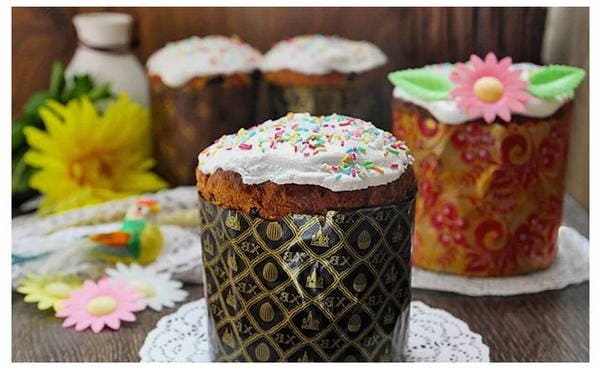Easter cake on yolks with dry yeast
0
1477
Kitchen
Russian
Calorie content
383.4 kcal
Portions
8 port.
Cooking time
7 h.
Proteins *
7.1 gr.
Fats *
13.8 g
Carbohydrates*
57.7 g
What could be better than Easter cakes made with love with your own hands ?! The process of making cakes is a magical time when a festive atmosphere begins to reign in the house. The smell that spreads throughout the district when baking fragrant Easter cakes fascinates everyone and reminds of the upcoming holiday. We offer you another recipe for making Easter cake on yolks with dry yeast, it turns out to be tender, tasty and aromatic, retains its softness for a long time.
Ingredients
Cooking process
Add butter softened in a microwave oven to the dough, knead well and put on a table sprinkled with flour. Pour vegetable oil into a glass or a small bowl so that it is convenient for us to wet our hands in it. Thanks to the vegetable oil, the dough will not stick to your hands, and the cakes will be more crumbly and will keep their freshness longer. Add flour to the dough in small portions, kneading well each time. Flour for cakes may take more or less than indicated in the recipe, it all depends on the quality of the flour. It is necessary to be guided by the dough: it should be soft enough, not tight. At the end of kneading, add raisins to the dough, slightly boned in flour and, kneading, evenly distribute it over the dough. Then we put the dough in a deep container, cover it with cling film and leave it in a warm place for 2-3 hours so that the dough rests from kneading and rises.
After the dough has risen, put it on a table sprinkled with flour, knead it with your hands, divide it into parts and arrange it into shapes. The form should be filled with a test no more than half.We leave the molds with the dough for 2-3 hours in a warm place so that the dough will fit well again. Then we put them in an oven preheated to 180 degrees and bake for 25-50 minutes. The baking time depends on the size of the cakes. When ready, we take the cakes out of the oven and leave to cool at room temperature.
Prepare the protein fondant: in a clean dry container, use a blender to beat the egg white until a white foam forms. Then gradually add powdered sugar to the protein. As a result, we should get a white thick mass. Lubricate the cooled cakes with it, decorate them with sprinkles and let the fondant freeze. Our Easter cakes are completely ready for tasting, bon appetit!









